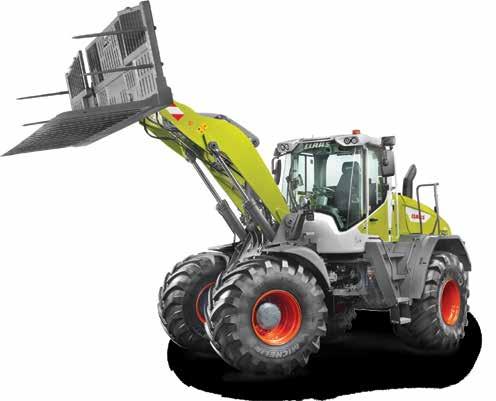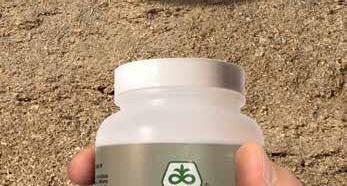NZ-China trade under strain? PAGE 3

PRECISION NITROGEN
APPLICATION
Cost v benefit
UFORCE TO RECKON WITH UTV upgrade
Page 13



NZ-China trade under strain? PAGE 3

PRECISION NITROGEN
APPLICATION
Cost v benefit
UFORCE TO RECKON WITH UTV upgrade
Page 13


Gallagher and LIC partnership to optimise breeding, feeding decisions. PAGE 4

When it’s complete, New Zealand’s largest solar farm will have a whopping 330,000 photovoltaic panels.
But that’s nothing compared to your farm, right now.
You have millions of solar panels per hectare, generating energy every day.
Just because they’re small, green leaves doesn’t mean they’re any less efficient at capturing sunlight than big, black boards.
And the best bit is you can extract even more power from them – while limiting greenhouse gas emissions and nitrogen leaching – with one simple change to your system.
All you have to do is graze them at the right leaf stage.
As Barenbrug pasture specialist Graham Kerr explains, this not only maximises feed growth and quality, but enhances pasture longevity and farm efficiency.
Sound too be good to be true? It’s because we’re not grazing our main pasture grass correctly. If we do, multiple benefits compound.
“Typically on NZ dairy farms, we graze pastures too early, when ryegrass plants have

2 to 2.5 leaves a tiller, because that’s easier. But from the plant’s point of view, the perfect time to graze is when the pasture reaches 3 leaves.
“And while that sounds like a small difference, it can have a big effect as we typically graze just when ryegrass is starting to grow at its maximum!
“Modifying our management will affect ryegrass yield, metabolisable energy, persistence and even how much protein goes into the
cows, which in turn influences how much nitrogen comes out.”
The science behind this principle has been wellresearched over the past 20plus years.
Now, however, Barenbrug has gone a step further, and started testing it against individual ryegrass cultivars.
“As far as we know, no-one else has done this in the field for specific cultivars. We want to demonstrate exactly what happens when you continually
graze at 2, 3, or 4 leaves for our tetraploids, diploids, perennials and hybrids .
“Just as importantly, we want to see if there are any differences between them that we can harness.”
The first two year field trial tested Array diploid perennial ryegrass, 4front tetraploid perennial ryegrass and Forge tetraploid hybrid ryegrass.
Each was cut at 2, 3 and 4 leaves, and samples were measured for dry matter yield,
metabolisable energy, and protein.
Data has aligned with expectation, Graham says:
• Metabolisable energy for 4 leaf ‘grazing’ is lowest – it’s too late, so some older leaves die.
• Dry matter yield is 19% lower for 2 leaves than 3 – grazing too early means yield is lost before it reach potential.
• Over the same leaf stage crude protein levels drop 6% - significantly decreasing excess protein in the grass.
Daughter tiller numbers – a key to pasture longevity – are lowest at 4 leaves, as these get shaded.
Further testing continues with pre-market diploid perennial ryegrass cultivars.
But farmers can benefit from the principle straight away, Graham says.
“There’s money to be made here in terms of productivity and efficiency by capturing a greater percentage of the sun’s energy.
“The more quality feed we grow and utilise on farm, the better off we are. And this change is exciting as it captures both profitability and environmental gains.”

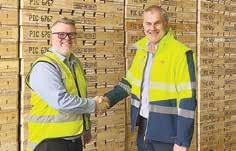
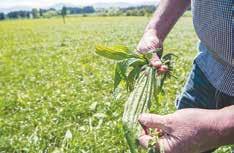

THE WORLD is now amid potentially one of the most disruptive periods in world trade for a very long time.
That’s the view of international trade specialist and former diplomat Stephen Jacobi who says the new Trump administration is making even bigger policy changes than when they were in power four years ago. He points out that the US has put an additional 10% tariff on goods from China and it in turn has protested to the World Trade Organisation (WTO).
But Jacobi told Dairy News that China is unlikely to find a solution from the WTO given that the US has refused to recognise the appeals process of this world trade body.
“China’s response has been very measured. They have not applied further tariffs to US goods across the board, rather they have highlighted a few policy things they want to address. Maybe they are thinking they can do another deal with Trump as they did last time,” he says.
However, for all that, Jacobi says things are not good because they give rise to significant instability, uncertainty and potentially trade diversion. He says the whole geopolitical situation is one of uncertainty and no one quite knows what poli-

cies Trump is going to implement. He says the known is the tariffs on steel and aluminium “But we don’t know much about the full extent of any anything else, so it’s a pretty uncertain time,” he says.

New Zealand is the largest exporter of dairy product to China, with an estimated 42% market share in 2023.
Other key importers include the US, Germany and Australia. China
THE RECENT squabble between the Cook Islands and NZ over their deal with China has added a new element of tension in the relationship between China and NZ
This has been further exacerbated by the presence of Chinese navy ships in the Tasman Sea Stephen Jacobi says these incidents are deeply unhelpful for NZ trying to maintain a constructive relationship with China
He says NZ cannot afford to antagonise the Chinese
“I can’t help thinking that the way that China has played its hand suggests that they are not as well disposed to us as they might have been in the past,” he says Jacobi has been in Australia in the past week attending a meeting of the APEC business Council (ABAC) - an independent high-level group of business people who advise the economic leaders of the Asia-Pacific Economic Cooperation (APEC) on priority issues for business in the region
accounts for 35% of all New Zealand dairy exports, according to the Ministry for Primary Industries (MPI). Government sources suggest that NZ must keep its head down and stay below the radar. It could almost be described as ‘walking on eggshells diplomacy’ with the NZ Government being extremely measured in its responses. Jacobi says until NZ gets a better idea of what is actually being contemplated and how it might be applied to us, “I don’t think there is any point in going out on the front foot and antagonising the Americans”.
“We are in a situation of watching and waiting and quietly despairing for the future of global trade, more than the future of our trade,” he says.
He says there was a lot of concern among members about the possible impacts of what might happen, but he says they all seem to agree that it’s best to wait and see what actually develops and then be nimble in response
Jacobi says NZ and other ABAC partners still have a lot of investment in the future of the global rules based system and if the US wants to take itself out of that, NZ still has the rest of the world to deal with

TWO AGRITECH companies have joined forces to help eliminate manual entry and save farmer time.
Gallagher has partnered with LIC to make year-round decision-making more targeted and end-of-season reporting easier.
They have launched a new data integration which automatically transfers farmers’ live animal weighing data from Gallagher Animal Performance software directly into MINDA, eliminating manual entry and saving time. MINDA is farmer-owned cooperative LIC’s cloudbased herd management system.
Weighing young stock provides valuable insights to help farmers optimise breeding and feed-
ing decisions, whether animals stay in the herd or are part of a dairy beef strategy. Meeting liveweight targets at mating and calving improves fertility, milk production, and long-term profitability. It also helps meet market requirements and capitalise on strong payouts.
LIC chief executive David Chin says LIC’s focus on industry collaboration is a key driver for progress.
“The long-term success of New Zealand’s dairy sector relies on partnerships like this one. LIC prioritises working with industry leaders, scientists, and farmers to deliver sustainable and profitable solutions. By leveraging richer animal data in MINDA, we’re helping farmers maximise
LIC says that by leveraging richer animal data in MINDA, it’s helping farmers maximise the genetic potential of their herds.

the genetic potential of their herds while contributing to better industry benchmarking.”
Farmers weighing their heifers can now see liveweight data in MINDA as soon as they sync their Gallagher weighing system. This allows them
to quickly spot underperforming animals and adjust feeding plans.
Tracking growth in MINDA also supports better breeding decisions, says LIC, ensuring heifers hit key weight milestones for a productive future in the herd. Liveweight
monitoring can also help detect health issues early, allowing farmers to intervene before problems escalate.
Gallagher Animal Management chief executive Lisbeth Jacobs says connected systems are crucial to simplifying
farm management.
“Farmers have been asking for systems that talk to each other, and this partnership delivers on that,” Lisbeth says. “We know technology is more effective when it works together.
“By syncing liveweight data straight into MINDA, we’re making it easier for farmers to access accurate, actionable information that helps them manage their herds and feed more efficiently. It is important farmers retain ownership of this data. Our job is to ensure they get the most value from it by making it accessible where and when they need it.”
Chin and Jacobs agree that collaboration and responsible data sharing are essential to the future of farming.
“Having systems in place to easily share data - whether it’s liveweights, herd data, or health records - makes a big difference to farm productivity and profitability,” says Chin.
“This partnership ensures farmers retain full control of their data and enables them to make informed decisions at a farm level.”
Jacobs points out that the partnership is about more than just technology. “It’s about empowering farmers to achieve their goals - whether that’s hitting liveweight targets, breeding more efficient cows, or meeting market demands. By saving time and unlocking valuable insights, we’re giving farmers the tools they need to succeed.”
DAIRYNZ IS supporting a proposed new learning model for apprenticeships and traineeships that would see training, education, and pastoral care delivered together to provide the best chance of success.
The Government is consulting on the future of work-based learning in the vocational education and training system and has two options for consideration.
An independent work-based learning model would mean a learner receives both education and pasto-
ral care from an approved training provider, while a collaborative workbased learning model would involve both a provider to manage education, and an Industry Skills Board to provide pastoral care to each learner.
DairyNZ senior people specialist Jane Muir says DairyNZ supported the independent work-based learning model.
“We want to see an adequately funded system that prioritises learners while also ensuring value for the employer, to ensure the best chance
of success for all involved,” she says.
“The relationship between the learner and the provider is crucial and separating the pastoral care from the organisation most invested in their success simply adds more costs and a layer of complication.
“Building work-based capability on-farm is of critical importance.”
Muir points out that DairyNZ is in a unique position with Dairy Training Limited (DTL), a subsidiary of DairyNZ, being well-equipped with practical insight and expertise into
the opportunities and challenges of delivering vocational education successfully.
She says any new system needs to support private training establishments, such as Dairy Training Limited, to continue to grow.
A recent survey showed that 95% of DTL students either agreed or strongly agreed that their capability improved as a result of completing a DTL course.
DTL course enrolments have also increased by 500% over the past 5
years and continue to grow, she says.
“That’s why we believe a DTL model adds value to the dairy sector and has potential to grow.
“As a sector, dairy farming generates more than $25 billion in exports for New Zealand, and it’s our people on-farm that help us realise this potential.
“It’s more important than ever that we’re able to respond quickly to change and we can only do that with the right funding and training structures in place.”

ative -66% in July 2024 to a net positive score of 2%.
and interest rates play a huge role in shaping farmer confidence, but these factors are beyond their control, says Federated Farmers dairy chair Richard McIntyre.
He says to do its share to help lift farmer confidence, Federated Farmers has been focusing its energy on what it can influence – making sure farming rules are practical, affordable and fair.
McIntyre made the comments as Federated Farmers’ January survey shows farmers’ confidence in current general economic conditions has surged from a deeply neg-
This marks the largest one-off improvement since the question was introduced in 2016.
Meanwhile, a net 23% of farmers now expect better economic conditions over the next year –the highest confidence level since January 2014. There has also been a sharp lift in profitability, with 54% of farmers now reporting making a profit –double the number in the last survey six months ago.
McIntyre told Dairy News that it’s incredibly satisfying to see farmer confidence rebounding so strongly, particularly in the dairy sector.

“It’s been a tough few years for many dairy farming families with incomes down, costs up, and unpaid bills starting to pile up on the kitchen bench.
“I think we’re seeing a collective sigh of relief
as some of that pressure starts to lift.”
McIntyre notes that there’s no denying that interest rates and commodity prices play a huge part in farmer confidence.
“In fact, I’d go as far as saying that farmer
confidence is tied very closely to interest rates.
“But they’re also not the only factors. We’ve seen in the past that low interest rates and a good dairy payout doesn’t always mean farmer confidence will lift. You’ve also got to have the right regulatory settings for farmers so they can see a future for their business that’s worth investing in.
“We can’t control interest rates, and we can’t control the milk price, so Federated Farmers have been focusing our energy on what we can have influence on – making sure farming rules are practical, affordable and fair.”
McIntyre says his organisation will continue working on helping
boost farmer confidence. This includes keeping the focus on banking.
“We’ve got our 12-point plan for restoring farmer confidence, and we’re going to keep working to that. Having a plan is only half the battle. You’ve also got to execute it.
“The Government have been working through that list of 12 very quickly, but announcements aren’t enough. We need to see them follow through with the detail and deliver meaningful policy change for farmers.
“One of our biggest focuses for the next few months is going to be banking – we’ve just presented to Parliament’s banking inquiry earlier
this week and we’re doing everything we can to keep the heat on.
“This is partly about the banks and how they treat farmers, but the issue’s a lot more complex than that. We’re also looking at the wider banking system, including the Reserve Bank rules, and how that impacts on farmers’ bottom lines.
“I’m also really keen to make sure the Government follow through and give young farmers access to their KiwiSaver to buy their first herd, flock, or farm.
“That would be a game changer for our next generation of farmers coming through who are desperately trying to pull together enough capital to get on the ladder.”
PLEASED, BUT cautious. That’s how PGG Wrightson chief executive Stephen Guerin says he’s feeling about the rural retailer’s latest financial result.
Last week, the company released its half-year results to December 2024. Those results saw earnings before interest, taxes, depreciation and amortisation (EBITDA) jump 13% and its net profit after tax (NPAT) rise by 25%.
It’s a marked improvement on the company’s 2024 full-year result which saw EBITDA drop 17% and NPAT
drop to $3.1 million.
However, Guerin says that he’s cautiously optimistic about the result as the sector’s economic conditions show early signs of improvement.
“We are seeing some improved confidence in the sector, that’s playing out in terms of the Federated Farmers survey… we’re seeing improved commodity prices for our farmer-growers,” he told Dairy News
The most recent Federated Farmers Farmer Confidence survey saw farmer confidence at its highest level in over a decade, surging from -66%


in July 2024 to +2% in January 2025.
“Interest rates are in our customers’ favour and hopefully that plays out in terms of improved confidence levels as well,” Guerin says.
However, he says the sector is still facing its challenges. “Not everything is looking up, there’s a few challenges within the sector,” he says.
“There is the conversation across the sector about what do tariffs look like for rural New Zealand, but until we see that detail, that’s just a conversation at the moment,” he adds.
“Until we see that detail, we’re just

getting on with life as the rural sector tends to do.”
Guerin says PGG Wrightson is “reasonably confident” for 2025.
He says there are more signs pointing towards improved farmer confidence and improved business outcomes for the retailer and its farmers than there are towards a negative year.
“There could be some movement in input prices for our farmers,” he says, adding that if those input prices were to rise, it could be a problem.
“There is a weaker New Zealand



dollar. That does improve commodity prices for sales output, but it does result in some higher input prices for our farmer clients. We’ve seen that recently with some of the fertiliser companies bringing their prices up.
“Commodity cycles do come and go, but if you look at the average and you look at the market indicators right at the moment, there are a few things that would suggest this has a wee way to run at the moment, but it doesn’t take much to knock some confidence,” he concludes.
– Jessica Marshall


things as disease-resistant and drought-resistant grasses and tools to help meet emissions targets.
DAIRYNZ SAYS potential benefits from gene technology must be carefully weighed against the risks of such technology.
This is one of the key recommendations in the industry good organisation’s submission to Parliament’s health committee which is in the process of examining the Gene Technology Bill.
The Bill seeks to end New Zealand’s near 30-year ban on gene technology outside the lab and is a major milestone in modernising our laws to unlock the potential of science. It is claimed that gene technology will deliver enormous benefits including access to better cancer treatments, and increased productivity for farmers through such
DairyNZ, like most other primary sector groups that have made submissions on the Bill, says it supports the overall intent to establish a new regulatory framework for gene technology and genetically modified organisms (GMOs).
It says the dairy sector stands to gain from streamlined access to gene technology via beneficial plant and animal traits, including pest/disease resistance. It also cites improved nutritional value, reduced greenhouse gas emissions, improved resilience to climate change, productivity gains, and improved animal welfare.
But according to DairyNZ’s chief science advisor Dr Bruce Thorr-

old, who wrote the submission, any potential benefits must be carefully weighed against the risks, including trade and market access challenges, co-existence issues, impacts on cultural values, and unintended consequences such as increased weediness or negative impacts on animal health. He says the health select committee should know the primary sector was given
very limited opportunity to contribute to the government reform process.
DAIRYNZ SAYS there is a need for greater primary sector input and advice than is currently provided for in the Bill and wants a dedicated primary sector sub-committee to the proposed technical advisory committee, as well as an expansion of the skill set of the committee
Thorrold says the other concern of DairyNZ relates to the Bill’s definition of ‘environment’ and says this should be clarified to confirm that it covers primary production systems, to ensure that primary sector issues are addressed
“There is a well-established system, and practices used for production of high-grade seed crops, which provide a working example of co-existence in practice
“DairyNZ has been working to raise awareness of gene technology and the reform process with farmers and other stakeholders over the past eight months. However, this has been very challenging due to the lack of detailed information from the Government on the proposed new regulatory framework,” he says.
This could serve as a useful starting point for the primary sector to lead the development of appropriate regulatory
settings for co-existence,” he says DairyNZ says officials should be tasked with considering a broader range of options for protecting Māori rights and interests, including expanding the proposed functions of the Māori advisory committee
Finally it wants a two-to-five transitional period with greater transparency in decision-making by the regulator or the Minister on matters relating to the primary sector It says for example this would ensure that no technologies or organisms are deemed ‘exempt’ during that period
Thorrold says this approach would enable trust and confidence to be built in the new regulatory system He says DairyNZ looks forward to working with government to refine and implement the legislation
Thorrold says the limited farmer engagement has shown that a diversity of views exists within the dairy sector, from strong support through to strong opposition. He says some farmers see significant potential in gene technology, while others have concerns about market acceptance, trade implications, ethical considerations, and potential risks to the environment or livestock. This view is echoed by other primary sector organisations including Beef+Lamb NZ.
Water and effluent can be both a valuable resource and a headache, depending on how they are managed. This special report will examine the latest technology available for efficient water and effluent management.

tions and elevated shipping costs.
THE COST of producing
milk in New Zealand continues to compare favourably with other exporting regions despite a lift in production costs over the past five years.
That’s according to Rabobank’s new ‘The cost of milk: dissecting milk production costs’ report, which says dairy farmers in many regions have felt the pressure of increasing milk production costs over recent years.
Report author Emma Higgins said those cost increases have been broad based, with the majority on ‘farm working expenses’ rather than other ancillary costs such as servicing debt, taxes and depreciation.
“The latest cyclical cost jump has occurred amongst a unique backdrop, differing from other price hike cycles.
“Farmgate feed and fertiliser cost increases resulted from inclement weather, the fallout of the Ukraine war increasing energy prices, trade and supply chain disrup-
“This coincided with monetary policy cycles shifting in response to Covid-induced inflation. Interest rates lifted rapidly, increasing the cost of servicing debts alongside the resulting general overhead cost inflation.
“At the same time, labour costs moved higher in response to a combination of policy settings or staffing shortages in most producing regions.”
Between 2019 and 2024, the average total cost for milk production across eight major exporting regions (Argentina, Australia, China, Ireland, New Zealand, the Netherlands, California and the US upper Midwest) increased by around US 6c/litre, or 14%, with over 70% of the increase occurring since 2021.
Last year saw all areas experience some relief, with interest rates declining in many regions. With feed expenses the largest culprit in cost increase across the eight regions, (+19% from 2019-24), yield improvements and


good weather saw feed receipts retreat alongside fertiliser costs, narrowing the cost band back to 2019 levels.
Higgins said that key cost categories varied by region, with feed costs generally lower for pasture based feed systems like New Zealand, the Netherlands and Ireland.
“In contrast, feed bills for more intensive farming systems like those in China and the US tend to make up a higher proportion of overall costs with this largely down to greater volumes of imported feed.”
Of the eight regions
assessed across the past five years, labour cost increases have been the most significant in Australia – jumping by over 50% since 2021 – while interest rate pressures have been felt the most by New Zealand, Australian and Argentinian producers.
With New Zealand and Australia competing over the past six years to hold the title of lowest-cost producer in US dollar terms among the eight assessed regions, New Zealand is currently in the lead with its cost advantage of US 5c/litre in 2024 (up from US 2c/
litre in 2023) due to Australia’s higher labour costs.
“The five-year average total cost of production sits at US 0.37c/litre for both New Zealand and Australia, compared to around US 0.48c/litre for the other regions,” explains Higgins. “The Oceania region’s strong reliance on pasture-grassing, supplemented with home-grown feed stuffs or locally produced-feeds has more broadly supported its low-cost of production positioning.
“With this comparison being made in USD, NZ and Australian production costs have also benefitted from a respective 9% and 8% discount in 2024 compared to 2019, based on a stronger USD compared to their local currencies.
“The downside of a stronger USD for non-US production regions is the impact on cost pressure for imported inputs. Fertiliser and fuel cost items tend to feel this pressure most keenly in Oceania, averaging around 15% of New Zealand farm working expenses in the last five years.”
EMMA HIGGINS said China remains the highest cost milk producer due to its high reliance on feed (60% of total cost of production) However, it has become more cost-competitive in the past three years with weaker feed prices in 2023 and 2024 helping to improve costs, supported by double-digit percentage declines in corn and soybeans prices in 2024
While the report does expect China to remain a dairy importer over the medium term, the increasing cost-competitiveness in domestic production will see ramifications for exporters who have historically relied upon a strong Chinese demand and a higher Chinese base price to support import price arbitrage
Since 2019, the regions generating the best cash flow on a gross milk price margin calculation basis (i e milk price minus operating costs) have been New Zealand, Australia and Netherlands, with constant positive milk gross margins through the cycles and lower volatility compared to other regions
However, Higgins says the dairy sector has experienced significant price and costs volatility during the past decade and that this will not change in the future
“As the geopolitical environment becomes more unstable, continued cost structure management relative to milk output will be required to maintain dairy farmers’ economic resilience in a potentially turbulent business operating environment – something Kiwi farmers have demonstrated in previous commodity price down cycles ”
She further adds that RaboResearch anticipates a variety of implications for dairy value chains will exist in the years ahead
These include volatile operating environments and increased regulatory pressure which will raise the complexity of dairy farming business as well as a need to focus on and optimise dairy cow nutrition and genetics
“Dairy producers will need to maintain strong milk margins to fund such productivity improvements within an increasingly complex business environment”








FONTERRA ISN’T backing down in its fight with Greenpeace over the labelling of its iconic Anchor Butter Greenpeace claims that new legal documents from Fonterra Brands reveal that the dairy giant has removed labels from its Anchor butter packaging which the environment lobby says falsely claimed that Fonterra dairy cows are ‘100% New Zealand grass-fed’
However, the co-op has hit back Fonterra says it stands behind its claims in relation to Anchor butter Fonterra labels its Anchor butter as “grass-fed” because its suppliers’ cows’ diet is predominantly grass and pasture, which includes grass, grass silage, hay and forage crops
Fonterra will continue to strongly defend the claims brought against it, and will not be commenting further while this matter is before the courts
NEARLY FOUR years after buying a 75% stake in Southland processor Mataura Valley Milk (MVM), A2 Milk is still struggling to take the plant to profitability
In its half-year results last month, A2 says the half year was characterised by higher GDT market pricing, plus higher milk volumes processed through the MVM site As a result, revenue of $57 4 million was $13 9 million higher than prior year, with EBITDA losses improving to $11 9 million, (1H24: $15 3 million)
The company continues to work on a range of initiatives to accelerate MVM’s path to profitability, which remains a key priority
A2 Milk bought the 75% interest in MVM from China Animal Husbandry Group (CAHG), which retains a 25% stake in MVM
THE FACT that plant-based dairy is struggling to gain a market foothold isn’t deterring new entrants
A US company, Bostonbased start-up Brown Foods, is preparing to showcase UnReal Milk, the world’s first lab-grown whole cow’s milk – produced without a single cow
According to its founders, UnReal Milk is produced using mammalian cell culture, replicating the nutrition, taste, and texture of traditional dairy It can be processed into butter, cheese, and ice cream, claiming to be a lower-carbon alternative to conventional milk Brown Foods claims its production method cuts carbon emissions by 82%, water use by 90%, and land use by 95%, without relying on livestock While the figures sound great, whether consumers like the product remains to be seen
DONALD TRUMP’S focus on Canada is causing concern for the country’s dairy farmers
While Trump wants to make Canada the 51st US state, it’s clear that the Canadian dairy industry is also on the president’s mind
The US is said to have long desired to expand access to the tightly controlled Canadian dairy market At the same time, Canada has strongly defended its supply management system Trump linked his threat to impose 25% tariffs on Canada and Mexico to claims about fentanyl and migrants And, when it comes to dairy, the new Trump administration is making it clear that Canada will face a familiar fight
Dairy trade might be small – the US exported US$1billion worth of dairy to Canada in 2023, while the total amount of goods shipped across its northern border was about US$354 billion – but the industry has a reputation as a long-time, cross-border irritant
Canadian dairy farmers hope the current trade imbalance in dairy, which greatly favours the US, will be a saviour Canada exported about $300m in dairy products to the US in 2023
Publisher: Brian Hight Ph 09-307 0399
General Manager: Adam Fricker Ph 021-842 226
FEDERATED FARMERS’ latest farmer confidence survey results won’t surprise too many people.
Falling interest rates, rising incomes, stabilising farm input prices and more favourable farming ‘rules’ have all played a major role in that improvement.
It’s incredibly satisfying to see farmer confidence rebounding so strongly – to its highest point in over a decade and the largest one-off lift in farmer confidence seen to date. This is a cause for celebration.
However, the results are coming off a pretty low base. And as Federated Farmers points out, farmer confidence is now in positive territory, but there’s still a lot of room for improvement.
Farmers can’t control either interest rates or the farmgate milk price, so Federated Farmers and other industry organisations are using energy on what they can influence –making sure farming regulations are practical, affordable and fair. This means keeping the Government honest.
Not all decisions made by the Government help farmer confidence. For example, the recent Nationally Determined Contributions (NDC) announcement by the Government hasn’t gone down well with farmers as it would mean more pine trees on productive land. The Feds’ survey was carried out before the latest NDC announcement and one can bet that this almost certainly would have taken some of the gloss off the results. Government rules and regulations have a significant impact on farmers’ costs and these costs really can make or break a season and have a significant impact on a farmer’s confidence to keep investing in their business.
Farmers have a simple message to the Government: “As a country, we’re never going be able to regulate our way to prosperity, but with the right policy settings, we might just be able to farm our way there”.
Head Office: Lower Ground Floor, 29 Northcroft St, Takapuna, Auckland 0622
Phone 09-307 0399.
Postal Address: PO Box 331100, Takapuna, Auckland 0740
by: Inkwise NZ Ltd Contacts: Editorial: sudeshk@ruralnews.co.nz
: davef@ruralnews.co.nz Rural
: www.ruralnews.co.nz
: subsrndn@ruralnews.co.nz AUCKLAND SALES CONTACT: Stephen Pollard Ph 021-963 166 stephenp@ruralnews.co.nz
Editor: Sudesh Kissun Ph 021-963 177
Machinery Editor: Mark Daniel Ph 021-906 723
markd@ruralnews.co.nz
Reporters: Peter Burke Ph 021-224 2184 peterb@ruralnews.co.nz
Subscriptions: Julie Beech Ph 021-190 3144
Production: Dave Ferguson Ph 027-272 5372
Becky Williams Ph 021-100 4831
Digital Strategist: Jessica Marshall Ph 021 0232 6446
NEW ZEALAND stands on the edge of a technology revolution. A revolution in the way we produce our food, manage our environment and treat our people. I say “edge” because what we, what our Parliament, decides in the next eight months will determine if we stay on the edge and watch the world pass us by, or stand on the cusp of this revolution.
I am talking about the Gene Technology Bill which is making its way through Parliament. There is a lot at stake. The world demands more food. Our customers demand better-quality food. They want us to reduce the impact we are having on the environment, they want us to reduce our greenhouse gases, they want food that is healthier. They are prepared to pay top dollar for these things.
Scientists in our universities and CRIs have been working on pastures which help reduce methane emissions and nitrogen leaching, improve animal welfare by reducing the chances of bloat and ryegrass staggers and on animals themselves in the face of climate change. They have accelerated apple breeding and
are working on kiwifruit.
Genetic modification is extremely popular with farmers. Around the world each year more than 16 million farmers have planted more than 200 million hectares of GM crops across 26 countries. Uptake by farmers, where they are allowed to use it, reaches above 90%. Farmers can’t get enough of genetic modification.
But here in New Zealand we have no or limited access to genetic technologies. Applications to develop life-saving medicines like CAR T-cell therapy can be held up for months by a sclerotic system that favours doing nothing. Our scientists have to fly to the US just to taste the apples they have bred.
In the last speech I gave as president of Federated Farmers, I spoke about the tension between scientific evidence and public perception. One observation I made is that trust takes time to build. That is what has been happening over the last decade as scientists have been informing the public of their work in gene technologies. We have heard about Professor Dearden’s wasp
gene drive programme, we have heard about AgResearch’s methane busting ryegrass and we have heard about sterile pines and fast breeding apples.
But it is another cliché that trust is hard fought and easily lost. We are seeing that play out in the rhetoric coming from those fundamentally opposed to gene technologies. We have heard that enacting the Gene Technology Bill will wipe $20 billion from our overseas earnings, that the Bill is a radical regulatory departure putting us at the bleeding edge of GM liberalisation. Neither is credible. Recently, I heard an activist, using his professorial title, emotive language and imagery to spread fear and mistrust about the Bill. He should know better but it is language designed to erode that trust in our scientists and regulators so hard fought, and it is not without effect... Gene technologies are not a silver bullet but they are an increasingly important tool as we face those challenges. Those who seek to spread disinformation to achieve their political aims do the country an immense disservice.
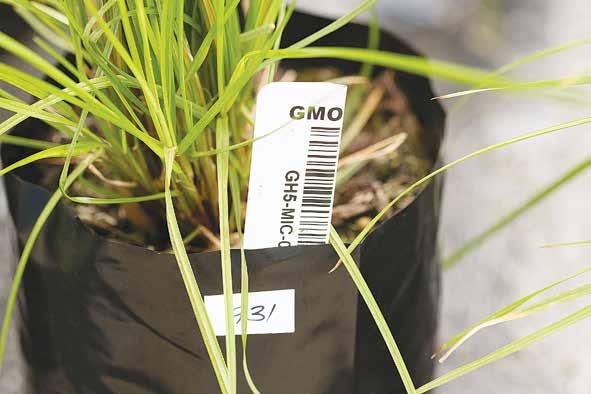

But humanity has been here many times before. Resistance to technologies and ideas is not new.
The dairy industry pushed back on margarine and, for the first half of the 20th century, it had to be dyed blue in North America. Until 1974, margarine in New Zealand was only available on prescription. Activists claimed it could make you go blind, but not just you, your children and grandchildren
also.
The world has separated into two factions: those countries who are using gene technology in agriculture and conservation, and those who are proceeding at a more cautious pace.
Those countries who use gene technology, like Australia, have regulatory systems that focus solely on the risk to human health and the environment; they apply scientific principles; they leave issues of trade and market access to industry; and ethics to parliament and ethics committees. They have given farmers choice and trust them to work together to achieve coexistence.
Contrary to the rhetoric we are seeing in submissions, their exports have thrived and so have their organic sectors. For them collectively, gene technology has increased crop production by almost half a trillion dollars, reduced annual CO2 emissions by 39 million tonnes, reduced pesticide use by 749 thousand tonnes and saved 183 million hectares of land, conserving biodiversity.
These countries have simply got on with it.
I expect to see more than 20,000 submissions opposing the Gene Technology Bill. While many will not have moved on since the ‘Corngate’ days of the 2000s or are react-
ing to misinformation, I think the silent majority of New Zealanders see gene technologies in a new light. Gene technologies are a part of our everyday lives. Polling of farmers has showed a majority support reform and choice – for themselves, their businesses and their families. We have prided ourselves on being at the forefront of environmental stewardship. What we do matters to others. They follow our leadership in this space. The next eight months will decide if we have indeed moved from the edge to the cusp, if we are in the coalition of science or the cabal of fear.

TIMPACK, ONE of New Zealand’s largest wooden pallet and bin manufacturers, has been reawarded an exclusive contract to supply Fonterra.
Timpack has been operating in Hamilton since 1984 and now has seven sites throughout New Zealand. Their team of 200 quite literally takes business places with production of more than a million items of wooden packaging annually.
The NZ-owned and operated company will retain responsibility for supply and maintenance of Fonterra’s pallet requirements for transportation of its goods throughout the nation and across the globe.
“Our relationship with Fonterra dates back to its inception in 2001, and can be traced back to our relationship with its predecessors when our own business was formed 40 years ago,” said Timpack managing director Alan Walters.
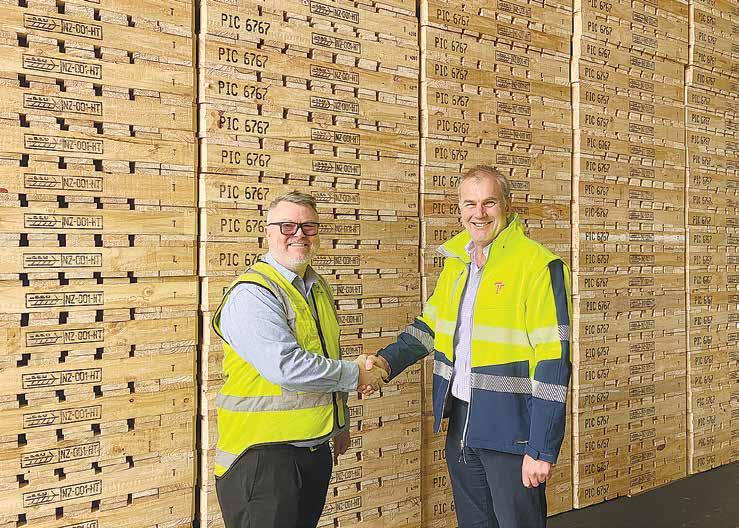
and service provided to Fonterra.”
Lawrence and Timpack manager, Debra Cowen, communicate daily, planning and forecasting individual Fonterra factory requirements to ensure Fonterra sites nationwide are supplied in a timely and efficient manner.
“Over the years, Timpack has worked with Fonterra to optimise the efficiency of the pallet and bin pool operations, ownership and management.”
Walters said the contract was the icing on the cake as Timpack celebrates 40 years in business this year.
“We see ourselves as a strategic partner rather than a supplier. To have our contract renewed for another five years is welcome news, and a vote in confidence that we’re continuing to live up to our promises.”
Walters said Timpack has an intimate understanding of the essential
role pallets hold within Fonterra’s supply chain, and the agility to forecast and respond to seasonal peaks with a reliable supply of pallets.
To meet Fonterra’s standards, the business
operates with an extensive quality system which includes a comprehensive risk management regime to ensure that each pallet is fit for purpose before leaving the site.
Fonterra’s national
pallet manager, Lawrence Hooker, said that after going to market, it was clear Timpack was the right company to partner with based on their proven capability to meet Fonterra’s dynamic and
globally unique requirements.
“Time and time again they have demonstrated willingness to invest in new technology, plant and equipment to assist in improving the quality
Billions of dollars’ worth of exports is shipped overseas on pallets each year, and hundreds of businesses spanning many industries including horticulture, dairy, construction, packaging and logistics, rely on Timpack’s products.
“We are immensely proud to move the goods that move New Zealand and look forward to the next 40 years in business.”
PROFESSIONALS IN South Waikato are succeeding in governance, thanks to a governance mentoring programme for South Waikato.
Funded by Community Governance Aotearoa, as part of their national action plan for community governance, led by SWIFT and facilitated by Mentoring Foundation NZ, this six-month initiative has been life-changing for participants like Chloe Jones, a 26-year-old regional operations manager for Fonterra, and John Natua, a New Zealand-born Cook Islands father of four who has worked in the public sector for over 20 years.
Jones, who juggles three jobs in the farming industry and serves as the volunteer board chair for NZ Young Farmers, joined the programme with an open mind, eager to improve her governance skills.
“I went in blind with no expectations, and it turned out to be the best approach I could’ve had,” Jones says.

insights into the complexities of governance.
One of the most impactful lessons she learned from Baldwin was understanding that every board is different and that whilst governance practices stay the same, they can be tweaked to the needs of each board to fit each unique environment.
“As a young professional at the start of my governance career, hearing from someone with a different experience that it’s normal for things to vary was reassuring,” she said.
The programme also helped Jones fine-tune her governance approach and build her confidence.
Farmers.
“Our board is unique, with members typically under 31 and facing the challenge of ‘forming, norming, and storming’ within a year. The governance insights I’ve gained have been influential in brainstorming and leveraging our board members’ skills to get the best out of them.”
Looking ahead, Jones is excited about her governance aspirations and aims to align them with her values and passions.
“I want to focus on farming boards and continue my career in this sector. The programme has given me a clear direction and the confidence to pursue my goals,” she says.
The programme paired her with Waikato dairy farmer Gray Baldwin, a seasoned board member of Farmlands and Ballance, who shared her farming interests. Their relationship grew through regular one-on-one meetings, where they discussed various governance scenarios over coffee.
“Gray and I had open and honest conversations about different topics, diving deep into the weeds,” Jones explained. These ‘situational discussions’ provided Jones with valuable
“It grounded me and helped me figure out my style, which is crucial when stepping into a boardroom,” Chloe said. “It also helped me build my own board and networks, providing me with a support system to sound out ideas.”
Jones has already applied her new skills to her role with NZ Young
SWIFT is now calling for expressions of interest for future governance mentoring and training programmes. Professionals eager to improve their governance skills and contribute to their communities are encouraged to contact SWIFT via email at info@swift.org.nz.
PRECISION APPLICA-
TION of nitrogen can improve yields, but the costs of testing currently outweigh improved returns, according to new research from Plant and Food Research, MPI and Ravensdown.
The study found that potentially mineralisable nitrogen (PMN) –a measure of nitrogen release from the decomposition of soil organic matter – can vary widely, both within dairy farms and across farms on different soil types and with different management histories. This variability means that targeted nitrogen application, which adjusts the rates of nitrogen fertiliser based on PMN tests, can boost yields in low-PMN areas and reduce excess N
application in high-PMN areas.
“Previous studies have shown PMN testing can improve the N use efficiency of annual crops. In this study we’ve shown that it can also predict variation in soil N supply and the response to N fertiliser on pastoral farms,” says Dr Mike Beare, lead researcher from Plant and Food Research.
“Where PMN measured in soils was high, we found an increase in pasture dry matter production per unit of fertiliser N applied to be typically 32 to 48% less than where PMN was low.
“Where more than 40kg N/ha was applied (as N Protect, PMN had no effect.”
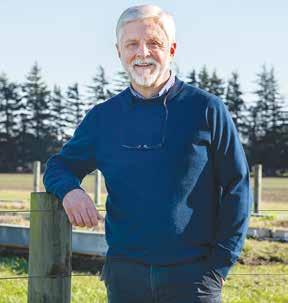
However, while the concept works, the increase in yield isn’t enough to offset the costs of testing, mapping, and variable rate application technology.
“We need practical solutions to improve N
use efficiency and minimise N losses that farmers can afford and apply at scale. The data we’ve gathered are valuable, but for this approach to become viable, the costs of the increased testing and to a lesser extent
variable rate application will need to come down and we need a better understanding of how PMN testing can help to reduce N losses and impacts on the environment,” Beare says.
The research was part of N-Vision, a collaborative programme with MPI, Ravensdown, Plant and Food Research, and Lincoln University aimed at improving nitrogen management on dairy farms, with the ultimate goal of improving nitrogen use efficiency and reducing environmental impacts all within the 190 kg/ha N cap. The programme is co-funded by the Government’s Sustainable Food and Fibre Futures (SFF Futures) fund.
The study took mea-
surements from seven different farms from five different regions over an 18-month period.
Researchers took measurements of PMN at 0-0.75cm depths, and also 0-15cm depths, and found that pasture dry matter production was greater in areas with higher PMN at both depths. However, the increase in pasture growth due to fertiliser was greater where PMN test values were lowest.
The study has now wrapped up, but the data gathered could still prove valuable for future research or if market conditions change.
“This research adds to our knowledge,” Beare notes. “If the cost of nitrogen rises or we find ways to lower testing costs, this could become
BUILDING ON the success of last year’s events, the opportunity to attend People Expos is back for 2025, offering farmers the chance to be inspired and gain more tips and insights for their toolkits to support their people on farm.
Dairy Women’s Network and DairyNZ are partnering again to deliver four People Expo events across the country, this year coming to Oamaru, Ashburton, Hawera and Hamilton.
“If you’re a dairy farmer that employs or manages people, join us

at one of the People Expo symposiums to hear from thought leaders on what’s needed to help tackle the big issues in empowering people for a productive workplace,” says DairyNZ.
“You’ll gain insights from experts, can connect with other farmers facing the same challenges, and come away armed with inspiration and practical tips to put in action with your farm team.
“While leading people can be tough, it is also necessary for good farm business management, and highly rewarding when you get it
right. The People Expo events can bring you the information to better understand workforce dynamics, ideas on actions you can take right now and inspiration to get you going.
“Carefully designed in a fun and enjoyable format for farm employers, managers, rural professionals and aspiring leaders, each event connects farmers and experts to share knowledge and ideas.”
Events are free to attend, and lunch is provided. Find out more and register online at dairynz.co.nz/peopleexpo
Speakers lineup: Shamubeel Eaqub - leading economist Shamubeel will speak to global, national, and regional economic and workforce trends and outline why farm businesses must act differently to stay successful and attract and keep people.
Jeremy Duckmanton – DMT Dairies Ltd
As a 50/50 sharemilker of 1,900 cows over two farms, Mid Canterbury dairy farmer Jeremy Duckmanton will talk to his farming journey and approach to achieving productiv-

for Cattle Troughs


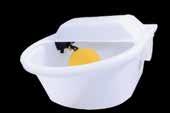
a useful tool for farmers in the future.”
The data have also enhanced our understanding of nitrogen cycling under pasture.
“We hope to use the data to identify the soil and environmental factors that could explain the wide variation in PMN observed on farms,” Beare says. Data could also be used to further improve the testing protocols for PMN, including options for reducing the costs.
For now, current best practice N fertiliser recommendations remain the most practical approach, but the findings offer insights that could lead to more efficient nitrogen management strategies in the future.
ity gains through different technologies and data.
Kim and Will Grayling – Singletree Dairies Limited
As equity partners in one of Canterbury’s largest dairy farming businesses, Kim and Will Grayling (Singletree Dairies Limited) share their experience creating a productive farm business through leadership. James Allen – AgFirst director James will talk to the dairy productivity story, including trends in New Zealand and worldwide, and the implications of these for farmers.



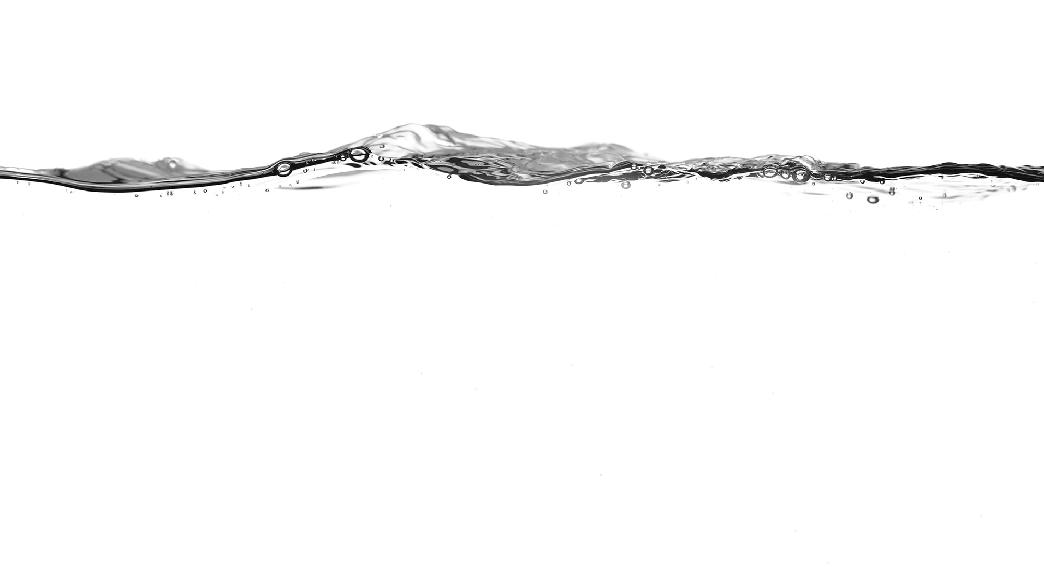

NOW IS not the time to stop incorporating plantain into dairy pasture systems to reduce nitrogen (N) loss, says Agricom Australasia brand manager Mark Brown.
Regardless of doubts raised last winter which challenged the interpretation of some of the science supporting plantain’s nitrate busting ability, Brown says farmers can confidently include the herb in their pasture systems and know it reduces N losses.
“We’ve never suggested plantain is the only pasture species that helps in the fight to reduce nitrate leaching in our pasture systems,” he says.
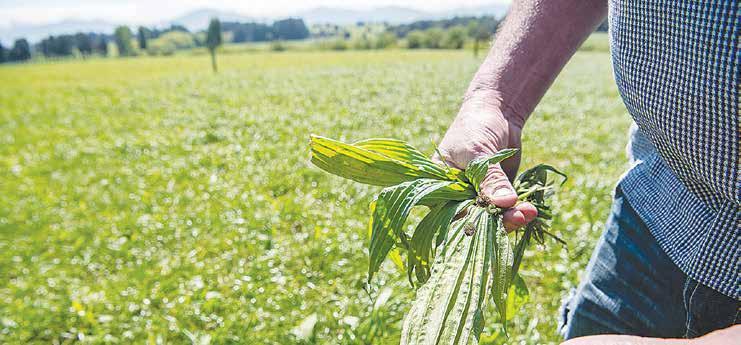
“But there’s 15 years of science and development behind Ecotain (plantain), OverseerFM recognises its ability to
BAY OF Plenty dairy farmer Richard Fowler says plantain has helped him maintain the stocking rate and production off his Rotorua Lakes catchment dairy unit
He operates two 250-cow herd properties, one in the sensitive Rotorua Lakes catchment and another further north near Te Puke, plus a 400ha dairy support and beef unit mid-way between the two dairy units
He was an early adopter of plantain before its capacity to reduce nitrogen leaching was confirmed by scientists and systems were tested by DairyNZ to guide farmers on how to incorporate it at a farm level
“We had dabbled in plantain years ago to see if it could help our
reduce N losses and several regional councils do too,” he says.
“For many dairy farmers, maintaining a good
cows handle facial eczema and grass staggers better We even sowed it as a crop and used it to grow out our heifers
“But once DairyNZ started testing different levels of plantain and how to manage it as a way to mitigate N loss, we got stuck in boots and all,” he says
For the past three years, it has been an integral part of the Rotorua property’s N loss management strategy
After getting advice from Agricom and looking at the DairyNZ work, he has settled on over-sowing plantain in prillcote form with his spring fertiliser applications at 2kg/ ha of seed (equal to 4kg/ha in prillcote form)
percentage of plantain in their farm’s pasture sward is one of the only ways they can fend off the pressure to reduce
That approach is delivering a reliable 20% component of plantain in the sward across his Rotorua Lakes catchment dairy unit
“At 20%, we basically get a nitrogen leaching saving equal to 6kg/ha which is a real gain for us, especially in this catchment
“We’re also wintering more cows off and applying less N fertiliser to help meet our leaching targets but using plantain has been a simple change that’s meant we’re able to maintain our cow numbers,” he says
Fowler says as long as plantain is recognised within Overseer, he will continue to maintain it at 20% of the pasture sward on his Rotorua Lakes catchment farm to capture the reduction in N loss
NEW RESEARCH just published in Ireland also supports plantain’s positive impact on N leaching and Mark Brown says the results closely align with those from the earlier NZ trials
The Irish trials investigated nitrate leaching over two years across different soil types from ryegrass-white clover swards with 0, 30 and 50% Ecotain plantain
On free draining soils, nitrate losses from swards with 30% Ecotain were 56% lower in year one and 96% lower in the second year, compared with the plots with 0% Ecotain Losses from swards with 50% Ecotain were 78% lower in year one and 98% lower in year two
The effect in poorly drained soils was much lower in the first year for swards with 30% and 50% Ecotain (6% and 21%), but matched the free draining soil results in the second year at 97% in the 30% swards and 98% in the 50% swards
In NZ farmlet trials at Lincoln University, plantain mixed swards averaged a 26% reduction in nitrate leaching over three years At Massey University, the nitrate leaching reduction over four years has also averaged 26% in the plantain mixed swards, ranging from 10% to 42% between treatments
At both sites, milk production from the plantainryegrass-clover swards has continued at similar levels to those with ryegrass-clover
stocking rate to meet their catchment’s N limit.”
Brown says the questions raised about plantain’s effectiveness created confusion among dairy farmers.
Many had already begun including plantain in their pastures, but Brown says some put their plans on hold because of the uncertainty which developed.
He directs farmers to two “counter-responses” which were published in the New Zealand Journal of Agricultural Research.
One was from scientists working on the Sustainable Food and Fibre Futures Plantain Potency and Practice programme and the other was from a group of scientists from AgResearch.
Brown says both responding groups stood by their earlier trial work which demonstrates plantain (Ecotain environmental plantain) is an effective mitigator of N loss from pasture systems.
He says a mid-term review of the Plantain Potency and Practice Programme, published in September last year, also concluded that plantain reduces nitrate leaching and can help improve freshwater quality. Article: Agricom



MARK DANIEL markd@ruralnews
ALREADY WELL
respected in the UTV sector for performance, reliability and a competitive price point, CFMOTO has upped the ante in the middleweight sector with the arrival of the UFORCE 600 Farm Spec model.
Featuring the same specifications as the already established 600 Plus model, Farmspec adds several features that increase the day-to-day practicality of the machine, making it a comfortable environment to spend a long day out on the farm.
Those features include
a factory fitted, automotive-grade, full length glass windscreen, which can be tilted open to increase airflow into the cabin, while also incorporating wipers and washer jets.
A pair of rear hinged, half doors, featuring a heavy-duty alloy frame, skinned with impact resistant polyethylene panels, offers occupants protection from debris and mud while also allowing a good airflow through the cabin. An impact-resistant polycarbonate rear screen provides excellent visibility and protection, while also being UV resistant.
Elsewhere, front bumpers protect the nose of the machine from impact

WHEN YOU compare a RAM 1500 or Chevrolet Silverado to a Ford Ranger or a Toyota Hilux, you will understand why we need the designations truck and ute.
Using the same logic, comparing a typical side-by-side with the Polaris Ranger XD 1500 will allow you to understand why the US manufacturer came up with a whole new categorythe Extreme Heavy Duty.
Launched in New Zealand in 2024, along with its XD 1500 NorthStar Edition sibling, the XD 1500 is equipped with a 3-cylinder ProStar, fuel-injected 1500cc engine pushing out 110hp and 142Nm of torque. This in turn is married to the SteelDrive transmission, that as the name suggests, uses a fully sealed and liquid cooled, 100% steel constructed drive belt.
Complementing that combination, the drive system offers On-Demand,

True All-Wheel Drive, 2WD, Turf and Ultra-Turf drive modes, alongside Comfort, Standard, Sport and Tow/ Haul settings. In addition, drive mode specific functions include engine braking and hill assist, with the latter allowing the vehicle to hold its posi-
tion and offer improved control when stopping or starting on slopes or hills.
Featuring 29-inch diameter tyres on 14-inch rims, the 1500HD has 38cm of ground clearance and 30.4cm of suspension travel, using a layout that uses dual “A” arms up front and dual
4-stroke engine with EFI that delivers 41hp/46Nm torque, with selectable Normal and Work modes. This is mated to a CVT transmission, equipped with electronic descent control, to take the drama away from travelling downhill. 2WD or 4WD can be selected to suit differing terrains, while lockable front and limited slip rear differentials maintain traction in the toughest conditions, while also minimising turf damage.
Suspension is taken care of by a double A-arm layout at the front and rear, complemented by coils springs and oil filled dampers with five preload settings. Bringing things to a halt falls to
arched “A” arms to the rear. A dry weight of 1,122kg spread over a 241cm wheelbase means the vehicle feels very sure-footed laterally, imparting a feeling of stability, while also delivering 680kg load and 1,588kg towing capacities.
In the cabin, increased legroom makes access easier, as does a new bottom mounting system for the door nets that help remove a trip hazard. Adjustable seating and a telescopic steering wheel allow users to get comfortable, while the additional bolstering to the side of the seats inspires confidence, while a flip-down centre seat gives driver and passenger the obligatory cup holders.
During a short test ride on a steep site under the shadows of the central Manawatu’s wind farms, east of Palmerston North, while it’s undoubtedly large, once on the move, it shows no
hydraulic brakes on all four corners. Equipped with 25-inch, 6-ply tyres fitted to alloy wheels, manoeuvrability is made easy with electronic power steering. Tipping the scales at 640kg, the Farmspec offers a 250kg tray and 680kg towing capacity, 96 litre stowage capacity, mainly under the two-person bench seat, alongside easy service access under the front panel, with engine access under the tipping load bed, that tilts to a 50-degree angle, that further helps with load discharge. The UFORCE 600 Farmspec is offered with a 2-year comprehensive warranty. www.cfmoto.co.nz
signs of being unwieldy. Indeed, after a brief period, the XD inspired confidence in both its travelling and climbing abilities, crossing deep drains and climbing very steep slopes with ease, while always being in control.
Offering 110hp on tap, power was never an issue, even on the steepest, longest climbs, while throttle response at slow speeds was infinitely controllable and coupled with the silky-smooth power steering, made new acquaintances feel at home quickly. Certainly, more expensive than more “normal” side-by-sides, the XD 1500 certainly makes a lot of sense for those carrying heavy loads or working on terrain that is too much for standard machines. Given that they are less expensive than many utes in the marketplace, they certainly warrant a closer look.
www.polarisnewzealand.com

WORKSAFE NEW Zealand is calling on farmers to consider how vehicles move inside their barns and sheds, following a sentencing for a death at one of South Canterbury’s biggest agribusinesses.
Louis van Heerden was crushed to death by a hydraulic tailgate on a trailer at Turley Farms Limited near Temuka in March 2022. The 45-yearold had been standing at the back of a dark, narrow shed as a spotter while grass seed was being tipped off the trailer.

WorkSafe investigators found Turley Farms had no specific plan in place for managing farm traffic indoors and that workers should not have been permitted in such a restricted space.
Turley Farms was sentenced at Timaru District Court last month, fined $247,500 and ordered to pay reparations of $201,477.
“Farmers are tempting fate if they think traffic only needs to be managed outdoors. Without a clear plan for how vehi-
cles and people move around indoor barns and sheds, it’s only a matter of time before something goes terribly wrong,” says WorkSafe’s area investigation manager, Steve Kelly.
“This is a good reminder to take a critical look at how tractors and other vehicles move around inside farm buildings. Clear separation of
vehicles and pedestrians is the key component.
Signage and designated safe areas are also simple and inexpensive ways to boost safety – especially when compared to a con-
viction and a fine.”
Following the fatality, Turley Farms has introduced reversing cameras, closing alarms, and isolation valves to the back of its trailers.
Vehicles are a leading cause of death and injury on New Zealand farms, which is why agriculture is a priority sector under WorkSafe’s new strategy. Agriculture accounts for around 25% of serious acute harm while having only 6% of employment.
WorkSafe warns that businesses must manage their risks, and WorkSafe’s role is to influence businesses to meet their responsibilities and keep people healthy and safe.
“When they do not, we will take action.”











company Lely reported a 3.4% decline in total turnover last year but notes that sales are picking up.
The Dutch company, a global leader in automated systems and data management for dairy farmers, presented its annual results for 2024 with a total turnover of €857 million (NZ$1.56 billion), compared to €888 million (NZ$1.6b) the previous year.
The company says the revenue decline of 3.4% reflects the global political uncertainty for dairy farmers and the agricultural sector in general.
However, it says that the last quarter of 2024 showed good resilience and a bounce back to
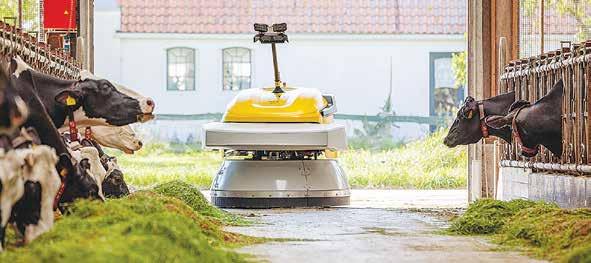
normal levels of sales, which gives confidence heading towards 2025.
Lely continues to invest 8.8% of total turnover in research & development for new innovations to realise the ‘Farm of the Future’.
Lely chief executive André van Troost notes that as 2024 has been a tough and challenging year, they are not sur-
prised by the slightly lower results.
The ongoing uncertainty in the agricultural sector globally, in combination with stricter regulations, increased production costs and low but gradually improving milk prices, make farmers hesitant to invest, he says.
“At the same time, we continue to see a grow-
ing demand for sustainably produced dairy with an expected growth in dairy intake of around 2% worldwide.
“Also, the adoption of robotics and data management continues to increase. Additionally, I am proud that we have launched three new products in September.
“These are important next steps towards
realising the Farm of the Future. We expect 2025 to be quite challenging, but we are confident that we are working towards a healthy future for generations to come.”
Van Troost says that the order book is slightly better than last year.
“In addition, we see higher milk prices and signs of declining interest rates for farmers. At the
same time, we observe ongoing uncertainty in the agricultural sector globally.
“We will continue to support our farmers worldwide in their work to produce sustainable and nutritious dairy products. The long-term outlook for robotics and data management remains very bright.”
Last year, Lely launched three “impactful solutions” for monitoring, feeding and manure handling at the Yellow Revolution event.
“With the launch of cow and barn monitoring system Zeta, feed pusher for large-scale farms Juno Max and next generation manure robot Discovery Collector C2 with sand flush accessory, we aim to answer the challenges faced by dairy farmers worldwide,” says
van Troost. He notes that last year, the adoption of robotics and data continued to increase globally.
“Thanks to our dedicated and focused Lely Center network, combined with well performing products, we see high customer satisfaction scores. Last year, we celebrated 20 years of Discovery manure solutions, the installation of the 50,000th Astronaut and the installation of the first Exos in Germany.
“In September we launched our new strategy for 2025-2030. Although the dairy sector remains our primary focus, we have included exploring alternative proteins as an additional source of income for the farmer. With our new strategy, we continue to build a bright future for our farmers.”
